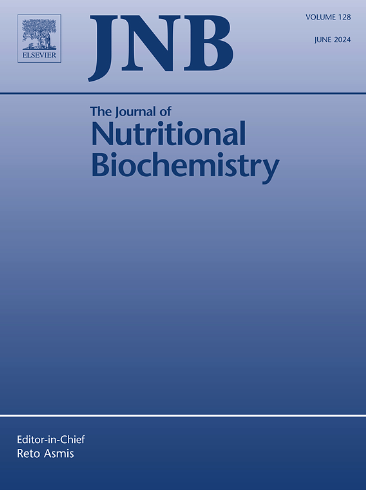用万古霉素和高纤维饮食改变微生物群会影响大鼠盲肠的短链脂肪酸/游离脂肪酸受体信号传导
IF 4.8
2区 医学
Q1 BIOCHEMISTRY & MOLECULAR BIOLOGY
引用次数: 0
摘要
本文章由计算机程序翻译,如有差异,请以英文原文为准。

Alteration of the microbiota with vancomycin and high-fiber diet affects short-chain fatty acid/free fatty acid receptor signaling in rat caecum
Microbial short-chain fatty acids (SCFA) regulate intestinal functions via free-fatty acid (FFA) receptors type 2 and 3. Though the caecum is the most important fermentation chamber in many species, it is unknown whether this signaling system is modulated in dependence on the rate of fermentation within the lumen of this part of the large intestine. Thus, we asked the question whether alteration of the microbiota composition by antibiotic treatment or high-fiber diet affects the SCFA/FFA signaling using rat caecum as model system. SCFA concentrations and microbiota were analyzed in caecal samples from untreated rats, following vancomycin treatment, or after feeding with a high-fiber diet. Oral and aboral caecal segments were harvested for Ussing chamber experiments paralleled by Ca2+ imaging experiments with Fura-2 loaded crypts, immunofluorescence, and qPCR. Vancomycin treatment reduced total SCFA concentrations in the caecal content, whereas the high-fiber diet increased the concentration of acetate, but reduced that of propionate and butyrate. Propionate-induced anion secretion was abolished in the vancomycin group, whereas it nearly doubled in the high-fiber group. These effects could not be explained by changes in the expression of FFA2 receptor or in Ca2+ signaling evoked by FFA2 receptor activation. Parallel changes in ion secretion evoked by carbachol suggest that alterations in cholinergic signaling might be responsible for the observed changes in epithelial ion transport. Additionally, mucosal mast cell and enterochromaffin cell density increased after vancomycin and high-fiber diet, respectively. This study emphasizes the complex interactions between the microbiota and the caecal epithelium focusing on SCFA/FFA signaling.
求助全文
通过发布文献求助,成功后即可免费获取论文全文。
去求助
来源期刊

Journal of Nutritional Biochemistry
医学-生化与分子生物学
CiteScore
9.50
自引率
3.60%
发文量
237
审稿时长
68 days
期刊介绍:
Devoted to advancements in nutritional sciences, The Journal of Nutritional Biochemistry presents experimental nutrition research as it relates to: biochemistry, molecular biology, toxicology, or physiology.
Rigorous reviews by an international editorial board of distinguished scientists ensure publication of the most current and key research being conducted in nutrition at the cellular, animal and human level. In addition to its monthly features of critical reviews and research articles, The Journal of Nutritional Biochemistry also periodically publishes emerging issues, experimental methods, and other types of articles.
 求助内容:
求助内容: 应助结果提醒方式:
应助结果提醒方式:


